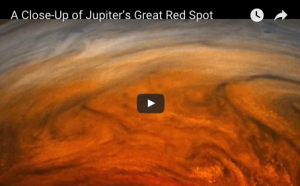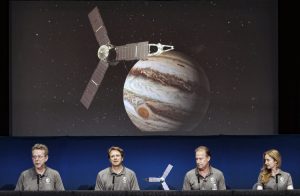Jupiter’s Great Red Spot


From WN
It’s been more than a month since the Juno probe flew over Jupiter, and while astronomers are busy analyzing the data, citizen scientists are producing incredible new images from the data supplied by JunoCam, IFL Science reports.
The latest image was created by Gerald Eichstädt and Seán Doran, after the flyby of July 10, and is published on NASA’s website.
The two citizen scientists processed images that were taken 16,535 kilometers (10,274 miles) from the tops of the clouds of Jupiter at a latitude of -36.9 degrees. The image is a composite of snaps taken by JunoCam, which are all available in a raw format online, where people can access them freely as well as help put them together. Astrophotography lovers like Eichstädt and Doran have been doing marvelous things with these raw images.
July 10 was the seventh flyby performed by Juno since its arrival at Jupiter in July last year. This flyby had a special target: the giant’s famous Great Red Spot.
“For hundreds of years scientists have been observing, wondering and theorizing about Jupiter’s Great Red Spot,” Scott Bolton, Juno principal investigator from the Southwest Research Institute in San Antonio, said in a statement after the successful flyby.
“Now we have the best pictures ever of this iconic storm. It will take us some time to analyze all the data from not only JunoCam but Juno’s eight science instruments, to shed some new light on the past, present, and future of the Great Red Spot.” – Scott Bolton
Scientists took detailed measurements of the Great Red Spot last April. It is now estimated to be 16,350 kilometers (10,159 miles) in diameter, or about 1.3 times as wide as Earth. The Spot is a gigantic hurricane, and scientists still don’t know exactly what’s causing it. While the spot has been a key feature of Jupiter, it might have been a relatively recent phenomenon.
Jupiter’s atmosphere is very complex, and understanding it is one of the Juno mission’s scientific objectives. The probe can measure the planet’s magnetic field and work out if its gravity is uniform or not. It can also see the planet in multiple wavelengths, which helps the scientists peering through the clouds. It is hoped that the Juno mission will lead to a better understanding of the Great Red Spot.
The eighth flyby of the spacecraft over Jupiter is planned for Sept. 1.
WN.com, JIm Berrie
For more on this story and video go to: https://article.wn.com/view/2017/08/18/juno_captures_new_closeup_images_of_jupiters_great_red_spot/






